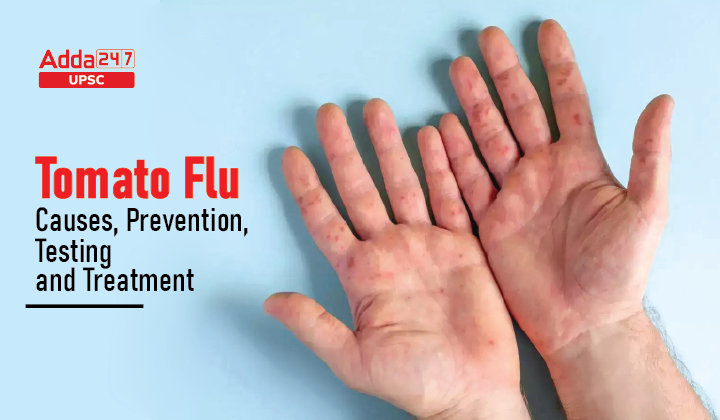Table of Contents
Tomato Flu- Relevance for UPSC Exam
- GS Paper 2: Governance, Administration and Challenges- Issues relating to development and management of Social Sector/Services relating to: Health.
Tomato Flu in News
- Recently, cases of Tomato Flu reported from at least four states — Kerala, Tamil Nadu, Haryana, and Odisha.
- In this context, the Union Health Ministry issued a set of guidelines on prevention, testing, and treatment of the Tomato Flue infection.
What is Tomato Flu?
- About: Tomato flu or tomato fever is characterised by fever, joint pain, and red, tomato-like rashes usually seen in children below the age of five years.
- Tomato Flue is accompanied by other symptoms of viral fevers such as diarrhoea, dehydration, nausea and vomiting, and fatigue.
- Symptoms: The red “tomato” rashes were traditionally restricted to the mouth (tongue, gums, and inside of the cheek), palms, and soles.
- However, now doctors are also reporting rashes on the buttocks, and a shedding of nails.
- Causes: researchers believe that it is hand-foot-and mouth disease (HFMD) caused by a group of enteroviruses (viruses transmitted through the intestine) like Coxsackievirus A-6 and A-16.
- Another pathogen — Enterovirus71 — that also causes the disease. However, this one is not very prevalent now.
- Impacts: In almost all cases, say 99.9% cases, the disease is self-limiting. But, in a small number of cases it can lead to CNS (central nervous system) complications.
Treatment for Tomato Flu
- There is no specific treatment or vaccine available for the Tomato Flu Disease.
- Those with the Tomato Flu infection are treated symptomatically, such as prescription of paracetamol for fever.
Prevention of Tomato Flu- Centre’s Advisory to States
As it happens mainly in children, the Centre’s advisory to states that was issued focuses on preventions in these age groups.
- As per the advisory, anyone suspected to have the infection should remain in isolation for five to seven days after the onset of the symptoms.
- It states that children must be educated about the infection and asked not to hug or touch other children with fever or rashes.
- The children should be encouraged to maintain hygiene, stop thumb or finger sucking, and use a handkerchief for a running nose, the advisory states.
- If a child develops symptoms, they should be isolated, their utensils, clothing, and bedding must be regularly sanitised, they must be kept hydrated, and the blisters must be cleaned using warm water
- It also states that testing should be conducted to take measures if there is an outbreak.
- Any respiratory, faecal, or cerebrospinal fluid samples (in cases with encephalitis or inflammation of the brain) have to be collected within 48 hours of illness.
- The biopsy of the lesions or skin scraping samples does not have such time limits.
Forever Chemicals: Per- and Polyfluoroalkyl Substances (PFAs)
Forever Chemicals: Per- and Polyfluoroalkyl Substances (PFAs)




 TSPSC Group 1 Question Paper 2024, Downl...
TSPSC Group 1 Question Paper 2024, Downl...
 TSPSC Group 1 Answer key 2024 Out, Downl...
TSPSC Group 1 Answer key 2024 Out, Downl...
 UPSC Prelims 2024 Question Paper, Downlo...
UPSC Prelims 2024 Question Paper, Downlo...





